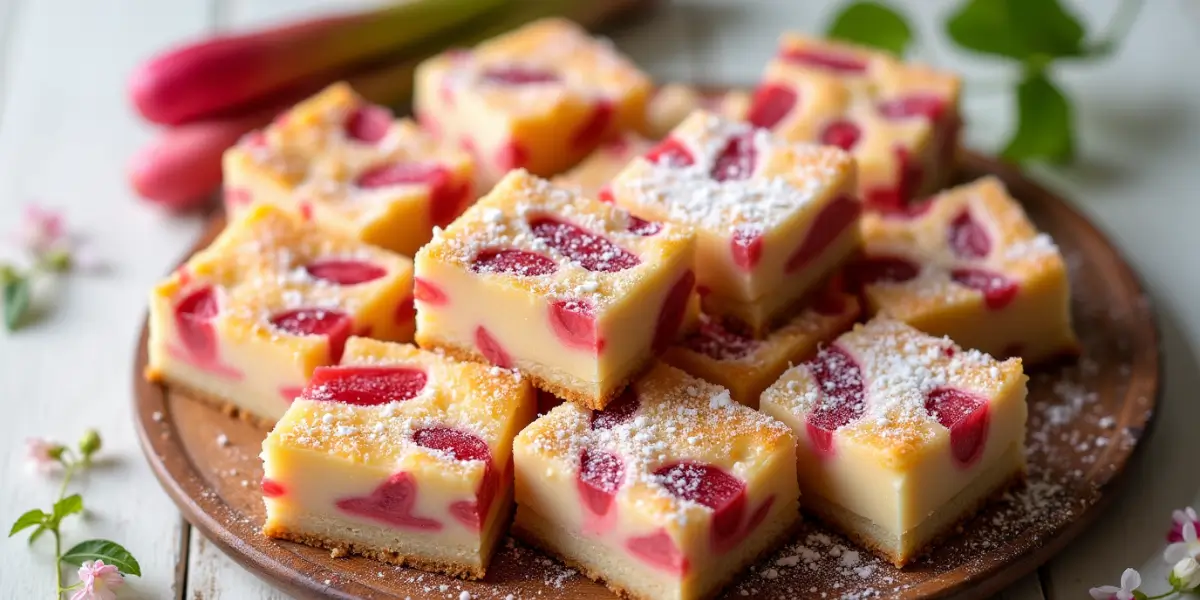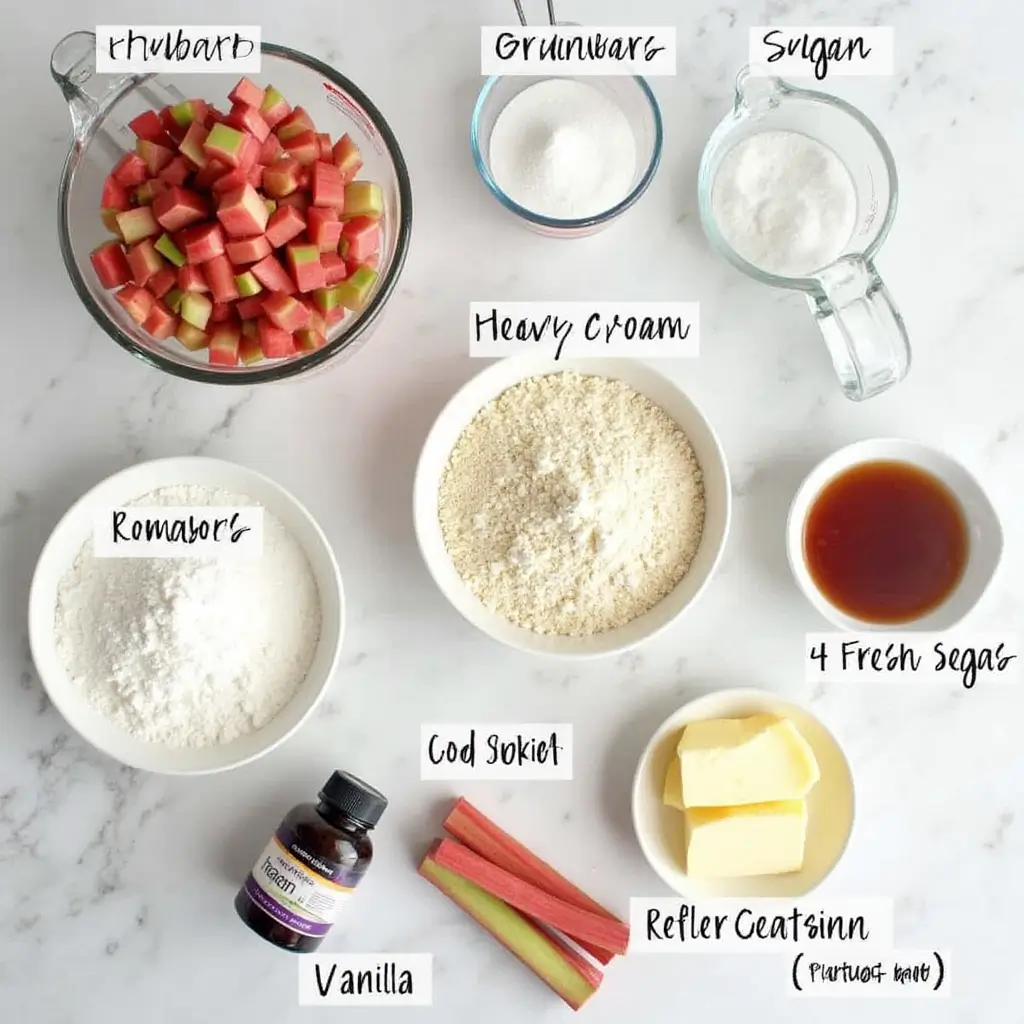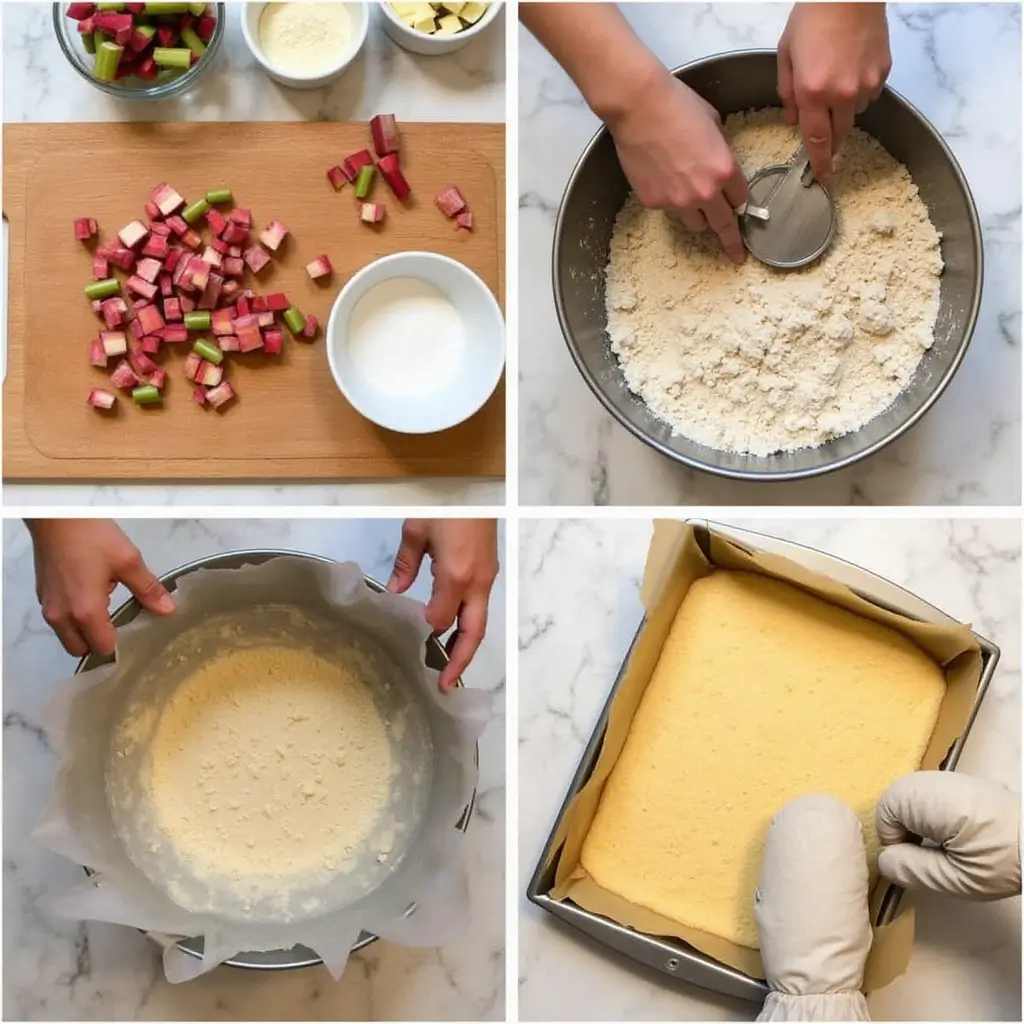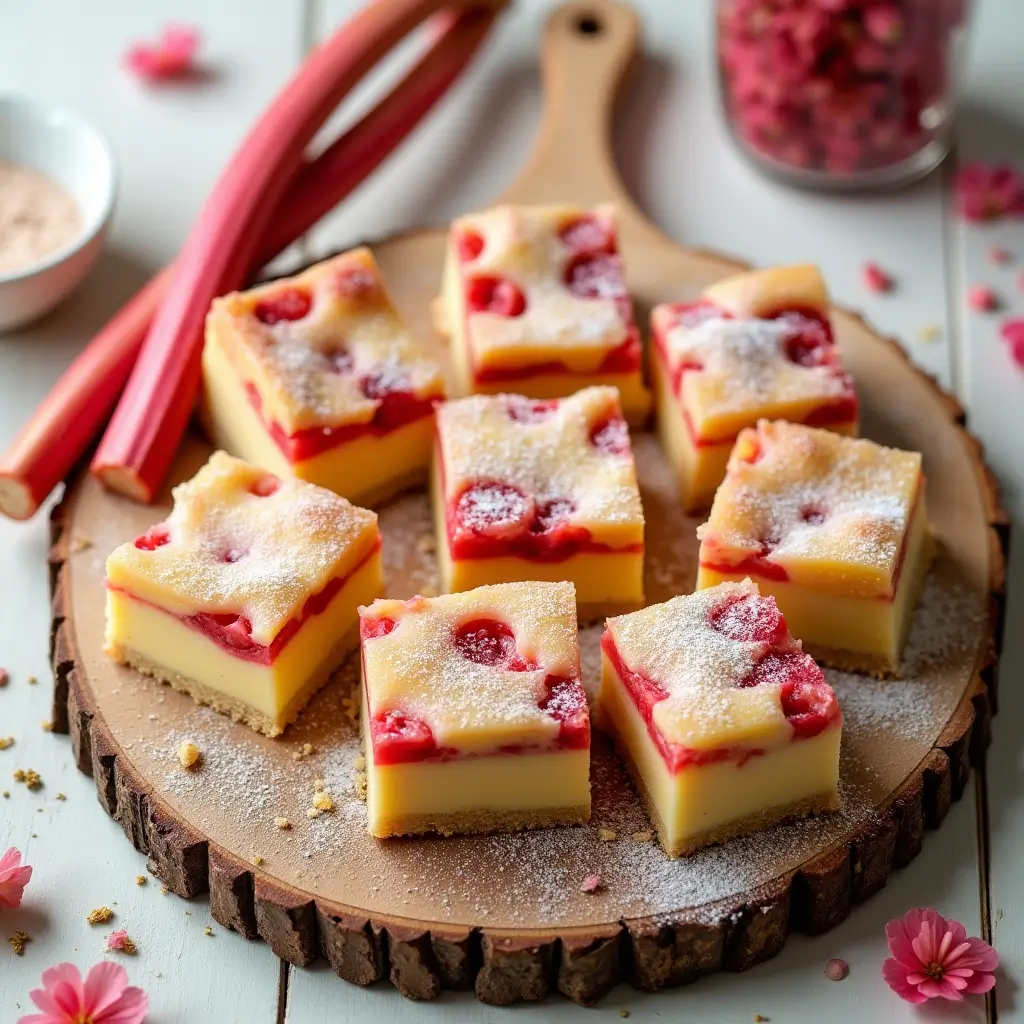Perfect Rhubarb Custard Bars Recipe

Picture this: you’re standing in your kitchen on a warm spring afternoon, the scent of fresh rhubarb wafting through the air as you pull a golden pan of rhubarb custard bars from the oven. The vibrant pink and green stalks have transformed into something magical – a perfect harmony of tart and sweet that makes your taste buds dance with joy. There’s something deeply satisfying about creating these incredible bars that capture the essence of spring in every single bite.
If you’ve ever wondered how to turn that abundance of rhubarb from your garden (or the farmer’s market) into something absolutely extraordinary, you’re in for a treat. These rhubarb custard bars aren’t just another dessert – they’re your ticket to becoming the dessert hero of every gathering, potluck, and family dinner.
The Magic Behind Perfect Rhubarb Custard Bars
Understanding Your Star Ingredient: Fresh Rhubarb
Rhubarb is truly one of nature’s most fascinating ingredients. While botanically a vegetable, we treat it like a fruit in our kitchens, and for good reason. The key to exceptional rhubarb custard bars lies in selecting the right rhubarb and understanding how to work with its unique characteristics.
When choosing rhubarb for your bars, look for stalks that are firm, crisp, and brightly colored. The best rhubarb for baking typically comes in early to mid-spring when the stalks are tender and not overly fibrous. You’ll want to avoid any stalks that feel soft or show signs of wilting.
The tartness of rhubarb varies significantly depending on the variety and growing conditions. Some rhubarb is mouth-puckeringly sour, while other varieties offer a more balanced flavor profile. This natural variation is actually a blessing for your rhubarb bars recipe – it allows you to adjust your sweetness levels accordingly.

The Perfect Custard Balance
Creating the ideal custard filling for your rhubarb custard bars requires understanding the science behind custard. A proper custard achieves that perfect creamy texture through the careful balance of eggs, dairy, and sugar. The eggs provide structure and richness, while the dairy adds creaminess and helps temper the eggs during baking.
The secret to a custard that sets properly without becoming rubbery lies in temperature control and ingredient ratios. Your custard should be thick enough to hold its shape when cut but still maintain that luxurious, creamy mouthfeel that makes these bars irresistible.
Building the Foundation: Your Shortbread Crust
The foundation of outstanding rhubarb custard bars is a properly executed shortbread crust. This isn’t just any ordinary crust – it needs to be sturdy enough to support the custard and rhubarb while remaining tender and buttery. The key is achieving the right texture that’s neither too crumbly nor too dense.
Your shortbread crust should provide a delightful contrast to the creamy custard and tart rhubarb. When done correctly, each bite offers multiple textures that work together harmoniously, creating a dessert experience that’s truly memorable.
Mastering the Art of Rhubarb Preparation
Choosing and Preparing Your Rhubarb
The success of your rhubarb bars recipe depends heavily on proper rhubarb preparation. Start by thoroughly washing your rhubarb stalks and trimming away any leaves (which are toxic) and any dried or damaged ends. The stalks should be cut into uniform pieces – typically about ½ inch chunks work perfectly for bars.
One crucial step that many home bakers overlook is managing the moisture content in rhubarb. Fresh rhubarb contains significant amounts of water, which can make your custard layer watery if not handled properly. Consider tossing your chopped rhubarb with a small amount of sugar and letting it sit for 15-20 minutes before use. This process draws out excess moisture that you can then drain away.
The size of your rhubarb pieces matters more than you might think. Pieces that are too large won’t cook through properly, while pieces that are too small can become mushy and lose their distinct texture. Aim for pieces that will soften during baking but still maintain some structure.
Balancing Sweetness and Tartness
One of the most challenging aspects of working with rhubarb is achieving the perfect balance between its natural tartness and the sweetness needed for a dessert. This balance is what separates good rhubarb custard bars from extraordinary ones.
The amount of sugar you’ll need can vary significantly based on your rhubarb’s natural tartness and your personal preferences. Start with the recipe amounts, but don’t be afraid to adjust based on your rhubarb’s characteristics. Remember, you can always add sweetness, but you can’t take it away.
Consider incorporating complementary flavors that enhance both the rhubarb and custard. Vanilla extract is classic, but orange zest, lemon juice, or even a hint of ginger can elevate your bars to new heights. These flavor additions should enhance, not overpower, the natural rhubarb flavor.
Timing and Texture Considerations
Getting the timing right when preparing rhubarb for your custard bars is crucial. Rhubarb releases moisture as it sits, so you’ll want to prepare it close to baking time. However, if you’re doing the sugar-drawing technique mentioned earlier, factor in that 15-20 minute window.
The texture you’re aiming for in the finished bars is rhubarb pieces that are tender but not mushy, suspended in a creamy custard that’s set but not rubbery. This requires understanding how rhubarb behaves during the baking process and adjusting your preparation accordingly.
The Complete Rhubarb Custard Bars Recipe
Essential Ingredients and Their Roles
| Ingredient Category | Specific Ingredients | Purpose | Tips |
|---|---|---|---|
| Shortbread Crust | 2 cups all-purpose flour, 1/2 cup powdered sugar, 1/2 cup cold butter | Creates sturdy, buttery base | Keep butter cold for best texture |
| Rhubarb Layer | 3 cups fresh rhubarb (chopped), 1/4 cup granulated sugar | Provides tart flavor and texture | Choose firm, bright stalks |
| Custard Filling | 4 large eggs, 1 1/2 cups granulated sugar, 1/3 cup flour, 1/2 cup heavy cream | Creates creamy, rich layer | Room temperature ingredients mix better |
| Flavor Enhancers | 1 tsp vanilla extract, 1/4 tsp salt, Optional: lemon zest | Balances and enhances flavors | Don’t skip the salt – it enhances sweetness |

Step-by-Step Baking Process
The key to perfect rhubarb custard bars lies in the methodical approach to each layer. Start by preheating your oven to 350°F and preparing your baking pan with parchment paper for easy removal.
For the shortbread crust, combine your flour and powdered sugar, then cut in cold butter until the mixture resembles coarse crumbs. Press this mixture firmly into your prepared pan – the pressure you apply here determines whether your crust will hold together properly. Bake for 15-18 minutes until lightly golden.
While your crust bakes, prepare your rhubarb by chopping it into uniform pieces and tossing with the 1/4 cup of sugar. Let this sit while you prepare the custard filling by whisking together eggs, sugar, flour, cream, vanilla, and salt until completely smooth.
Layer the prepared rhubarb over your partially baked crust, then pour the custard mixture over the top. Return to the oven for 35-40 minutes until the custard is set and lightly golden on top.
Baking Tips for Perfect Results
Temperature control is absolutely critical when making rhubarb custard bars. Your oven should be accurately calibrated – an oven thermometer is a worthwhile investment. Baking at too high a temperature will cause the custard to curdle, while too low a temperature won’t set the custard properly.
The doneness test for custard bars is different from regular cookies or cakes. The center should be set but still slightly jiggly when gently shaken. It will continue to set as it cools, so don’t overbake in pursuit of a completely firm center.
Cooling is just as important as baking. Allow your bars to cool completely in the pan before attempting to cut them. This patience will be rewarded with clean cuts and bars that hold their shape beautifully.
Advanced Techniques and Variations
Flavor Variations to Try
Once you’ve mastered the basic rhubarb custard bars recipe, you can explore exciting variations that will keep your dessert repertoire fresh and interesting. Consider adding strawberries to create strawberry-rhubarb custard bars – the classic combination works beautifully in this format.
For a more sophisticated flavor profile, try incorporating orange zest and a splash of orange juice into both the custard and the rhubarb preparation. The citrus enhances the rhubarb’s natural tartness while adding complexity to the overall flavor profile.
Spice variations can transform your bars entirely. A pinch of cardamom, cinnamon, or even fresh ginger can add warmth and depth. These spices pair particularly well with rhubarb’s tartness and the rich custard base.
Texture Modifications
If you prefer a different texture experience, consider adding a streusel topping instead of relying solely on the custard layer for the top. This creates an interesting textural contrast and adds visual appeal to your finished bars.
Some bakers enjoy adding chopped nuts to the shortbread base for extra crunch and flavor. Pecans, walnuts, or even almonds can complement the rhubarb beautifully without overwhelming the delicate custard flavor.
For those who prefer a less sweet dessert, reducing the sugar in the custard and allowing the rhubarb’s natural tartness to shine through creates a more sophisticated, adult-oriented treat.

Storage and Serving Suggestions
Proper storage of your rhubarb custard bars ensures they maintain their quality and food safety. These bars must be refrigerated due to the custard component. Store them covered in the refrigerator for up to 4 days.
For serving, these bars are delicious at room temperature or slightly chilled. If you’re serving them at a gathering, remove them from the refrigerator about 30 minutes before serving to take the chill off.
Consider dusting the tops with powdered sugar just before serving for an elegant presentation. The white sugar creates a beautiful contrast against the pink rhubarb and golden custard.
Troubleshooting Common Issues
Preventing Soggy Crusts
One of the most common problems with rhubarb custard bars is a soggy bottom crust. This typically happens when excess moisture from the rhubarb seeps into the crust during baking. The pre-sugaring technique mentioned earlier helps prevent this issue.
Another preventive measure is to ensure your shortbread crust is properly baked before adding the filling. The crust should be lightly golden and set – this creates a barrier that helps prevent moisture penetration.
If you consistently have issues with soggy crusts, consider blind-baking your crust completely before adding any fillings. This extra step ensures a completely crisp base that can better withstand the moisture from the rhubarb and custard.
Achieving Perfect Custard Consistency
Custard that’s too runny usually results from underbaking or incorrect ingredient ratios. Make sure you’re measuring your flour accurately – too little flour won’t provide enough structure for the custard to set properly.
Conversely, custard that’s too thick or rubbery often results from overbaking or too much flour. The custard should be creamy and smooth, not dense or chewy. Watch your bars carefully during the final stages of baking.
Temperature fluctuations during baking can also affect custard consistency. Avoid opening the oven door frequently, as this can cause temperature variations that affect how the custard sets.

Rhubarb-Specific Challenges
If your rhubarb pieces are too soft or mushy in the finished bars, you may be overbaking or using rhubarb that’s past its prime. Fresh, firm rhubarb should maintain some texture even after baking.
On the other hand, if your rhubarb pieces are too firm or fibrous, you might need to cut them smaller or cook them slightly longer. Very mature rhubarb can be particularly fibrous and may benefit from slightly longer baking times.
The color of your finished bars can vary significantly depending on your rhubarb variety. Some rhubarb produces beautiful pink hues, while other varieties remain more green. Both are perfectly fine – the flavor is what matters most.
Seasonal Considerations and Ingredient Sourcing
Making the Most of Rhubarb Season
Rhubarb season is relatively short in most climates, typically running from early spring through early summer. During peak season, you’ll find the best quality rhubarb at farmers’ markets and grocery stores. This is the perfect time to make multiple batches of rhubarb custard bars.
If you have access to garden-fresh rhubarb, you’re in for a real treat. Garden rhubarb is often more tender and flavorful than store-bought varieties. Harvest rhubarb stalks when they’re firm and brightly colored, typically in the morning when they’re full of moisture.
Consider preserving rhubarb during peak season for year-round baking. Chopped rhubarb freezes beautifully – simply clean, chop, and freeze in measured portions perfect for your favorite recipes.
Working with Frozen Rhubarb
When fresh rhubarb isn’t available, frozen rhubarb can be an excellent substitute for your rhubarb custard bars. However, frozen rhubarb requires slightly different handling to achieve the best results.
Frozen rhubarb typically releases more moisture than fresh, so you’ll need to account for this in your preparation. Consider thawing the rhubarb completely and draining excess liquid before using it in your recipe.
The texture of frozen rhubarb can be softer than fresh, so you might want to cut it into slightly larger pieces before freezing to compensate for the softening that occurs during the freezing and thawing process.
Quality Indicators for Best Results
When selecting rhubarb for your custard bars, look for stalks that are firm, crisp, and free from blemishes. The color can vary from green to red, and both are perfectly acceptable – color doesn’t indicate ripeness or quality in rhubarb.
Avoid rhubarb stalks that feel soft, have dark spots, or show signs of wilting. These quality issues will negatively impact the texture and flavor of your finished bars.
The thickness of rhubarb stalks can vary significantly. Very thin stalks may become too soft during baking, while extremely thick stalks might not cook through properly. Medium-thickness stalks (about 1/2 to 3/4 inch in diameter) typically work best for baking applications.
Recipe Card: Perfect Rhubarb Custard Bars
| Component | Ingredients | Instructions |
|---|
| Crust | • 2 cups all-purpose flour • 1/2 cup powdered sugar • 1/2 cup cold butter, cubed • 1/4 tsp salt | 1. Mix dry ingredients 2. Cut in cold butter until crumbly 3. Press firmly into a parchment-lined 9×13 inch pan 4. Bake at 350°F (175°C) for 15–18 minutes |
| Filling | • 3 cups fresh rhubarb, chopped • 4 large eggs • 1 1/2 cups granulated sugar • 1/3 cup all-purpose flour • 1/2 cup heavy cream • 1 tsp vanilla extract • 1/4 tsp salt | 1. Toss rhubarb with 1/4 cup sugar and let sit for 15 minutes 2. Whisk remaining ingredients until smooth 3. Layer drained rhubarb evenly over the baked crust 4. Pour custard mixture over rhubarb 5. Bake at 350°F for 35–40 minutes until set and lightly golden on top |
Yield: 24 bars | Prep Time: 20 minutes | Bake Time: 55 minutes | Total Time: 1 hour 15 minutes
Frequently Asked Questions About Rhubarb Custard Bars
Can I make rhubarb custard bars ahead of time?
Yes! Rhubarb custard bars are actually excellent make-ahead desserts. You can prepare them up to 2 days in advance and store them covered in the refrigerator. The flavors actually improve slightly as they meld together. For best results, cut the bars just before serving to maintain clean edges and optimal presentation.
How do I know when my rhubarb custard bars are done baking?
Your rhubarb custard bars are properly baked when the custard layer is set but still slightly jiggly in the center when gently shaken. The top should be lightly golden, and a knife inserted near the center should come out with just a few moist crumbs. Remember that the custard will continue to set as it cools, so don’t overbake in pursuit of a completely firm center.
Can I substitute frozen rhubarb in this rhubarb bars recipe?
Absolutely! Frozen rhubarb works well in rhubarb custard bars, though you’ll need to make a few adjustments. Thaw the frozen rhubarb completely and drain any excess liquid before using. Frozen rhubarb tends to release more moisture, so you might want to toss it with a bit of flour along with the sugar to help absorb excess liquid. The texture may be slightly softer than using fresh rhubarb, but the flavor will be just as delicious.
Why did my custard layer turn out too runny?
A runny custard layer in rhubarb custard bars typically results from underbaking, incorrect ingredient measurements, or excess moisture from the rhubarb. Make sure you’re measuring your flour accurately – the flour helps thicken and set the custard. Also, ensure your bars bake long enough for the custard to set properly. If your rhubarb released a lot of moisture, this can also thin the custard, which is why pre-treating the rhubarb with sugar and draining excess liquid is important.
How should I store leftover rhubarb custard bars?
Store your rhubarb custard bars covered in the refrigerator for up to 4 days. The custard component requires refrigeration for food safety. For the best texture and flavor, remove the bars from the refrigerator about 20-30 minutes before serving to take off the chill. These bars can also be frozen for up to 3 months – wrap individual portions in plastic wrap and store in a freezer-safe container.
Conclusion: Your Journey to Rhubarb Custard Bar Mastery
Creating perfect rhubarb custard bars is more than just following a recipe – it’s about understanding how each component works together to create something truly special. From selecting the perfect rhubarb stalks to achieving that ideal custard consistency, every step in the process contributes to the final result.
The beauty of these bars lies not just in their delicious flavor combination of tart rhubarb and creamy custard, but in their versatility and the joy they bring to those who taste them. Whether you’re baking for a spring gathering, looking to use up garden rhubarb, or simply wanting to try something new, these bars deliver on every level.
Remember that baking is as much about the journey as the destination. Don’t be discouraged if your first batch isn’t perfect – each attempt teaches you something new about working with rhubarb and custard. With practice, you’ll develop an intuitive understanding of when the custard is perfectly set and how to balance the sweetness to complement your rhubarb’s natural tartness.
The techniques and tips you’ve learned here will serve you well beyond just this single recipe. Understanding how to work with rhubarb, create proper custard, and build a sturdy shortbread base opens up a world of baking possibilities.
Ready to become the rhubarb custard bar expert in your circle? Start with this recipe, experiment with the suggested variations, and don’t forget to share your creations with friends and family. There’s nothing quite like the satisfaction of seeing someone’s face light up when they taste your homemade rhubarb custard bars for the first time. Happy baking!
Are You Try This Recipe ?
There are no reviews yet. Be the first one to write one.

